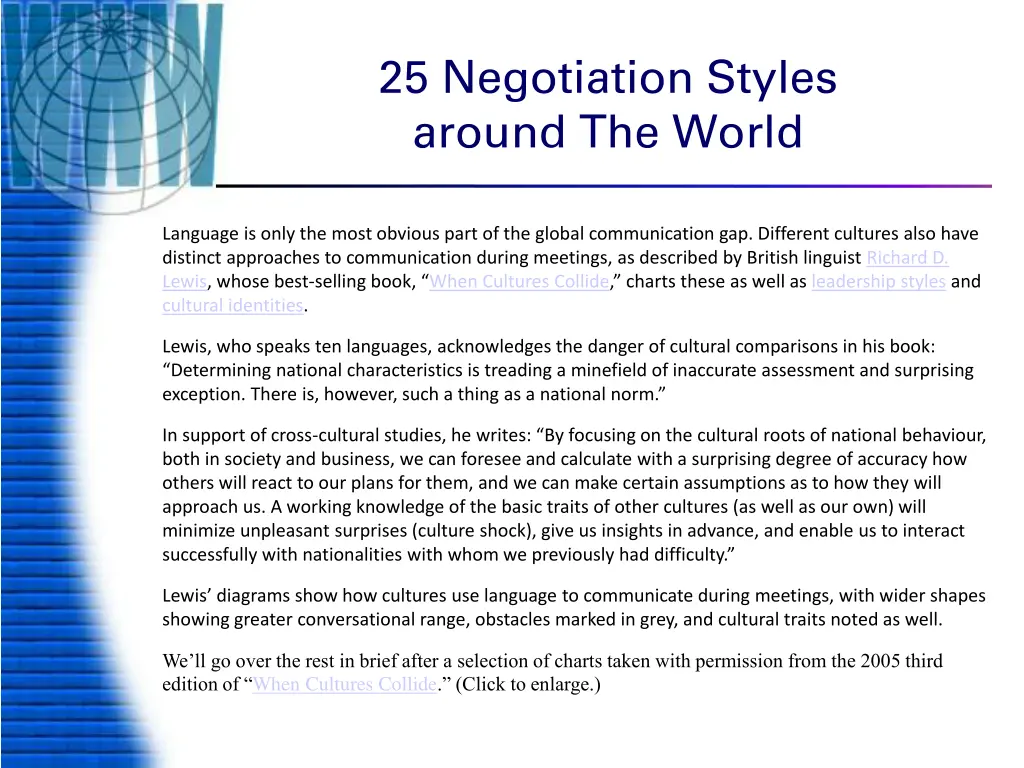
Negotiation Styles in Cross-Cultural Communication
Explore how different cultures approach communication and negotiation based on insights from Richard D. Lewis's book, "When Cultures Collide." Discover the distinct negotiation styles of American, English, Canadian, French, German, Swiss, Spanish, and Italian cultures during meetings.
Download Presentation

Please find below an Image/Link to download the presentation.
The content on the website is provided AS IS for your information and personal use only. It may not be sold, licensed, or shared on other websites without obtaining consent from the author. If you encounter any issues during the download, it is possible that the publisher has removed the file from their server.
You are allowed to download the files provided on this website for personal or commercial use, subject to the condition that they are used lawfully. All files are the property of their respective owners.
The content on the website is provided AS IS for your information and personal use only. It may not be sold, licensed, or shared on other websites without obtaining consent from the author.
E N D
Presentation Transcript
25 Negotiation Styles around The World Language is only the most obvious part of the global communication gap. Different cultures also have distinct approaches to communication during meetings, as described by British linguist Richard D. Lewis, whose best-selling book, When Cultures Collide, charts these as well as leadership styles and cultural identities. Lewis, who speaks ten languages, acknowledges the danger of cultural comparisons in his book: Determining national characteristics is treading a minefield of inaccurate assessment and surprising exception. There is, however, such a thing as a national norm. In support of cross-cultural studies, he writes: By focusing on the cultural roots of national behaviour, both in society and business, we can foresee and calculate with a surprising degree of accuracy how others will react to our plans for them, and we can make certain assumptions as to how they will approach us. A working knowledge of the basic traits of other cultures (as well as our own) will minimize unpleasant surprises (culture shock), give us insights in advance, and enable us to interact successfully with nationalities with whom we previously had difficulty. Lewis diagrams show how cultures use language to communicate during meetings, with wider shapes showing greater conversational range, obstacles marked in grey, and cultural traits noted as well. We ll go over the rest in brief after a selection of charts taken with permission from the 2005 third edition of When Cultures Collide. (Click to enlarge.)
American Americans, tend to launch right into negotiations, respond to discord confrontationally, and resolve with one or both sides making concessions.
English English tend to avoid confrontation in an understated, mannered, and humorous style that can be both inefficient and powerful.
Canadian Canadians tend to be more low-key and inclined to seek harmony, though they are similarly direct.
French French tend to engage vigorously in a logical debate.
German Germans rely on logic but tend to amass more evidence and labour their points more than either the British or the French.
Swiss Swiss tend to be straightforward and unaggressive negotiators, who obtain concessions by expressing confidence in the quality and value of their goods and services.
Spanish Spanish and Italians regard their languages as instruments of eloquence and they will go up and down the scale at will, pulling out every stop if need be to achieve greater expressiveness.
Chinese Chinese tend to be more direct than the Japanese and some other East Asians; however, meetings are principally for information gathering, with the real decisions made elsewhere.
Hong Konger Hong Kongers negotiate much more briskly to achieve quick results.
Singaporean Singaporeans generally take time to build a relationship, after which they can be shrewd negotiators.
Indian Indian English excels in ambiguity, and such things as truth and appearances are often subject to negotiation.
Korean Koreans tend to be energetic conversationalists who seek to close deals quickly, occasionally stretching the truth.
Indonesian Indonesians tend to be very deferential conversationalists, sometimes to the point of ambiguity.
Israeli Israelis tend to proceed logically on most issues but emotionally on some.
Australian Australians tend to have a loose and frank conversational style.
Hungarian Hungarians value eloquence over logic and are unafraid to talk over each other.
Danish Scandinavians often have entrenched opinions that they have formulated in the long dark nights, though they are reasonable conversationalists.
Finnish Finnish tend to value concision.
Norwegian And most Norwegians fall somewhere in between.
Swedish Swedes often have the most wide-ranging discussions.
Bulgarians Bulgarians may take a circuitous approach to negotiations before seeking a mutually beneficial resolution, which will often be screwed up by bureaucracy.
Dutch The Dutch are focused on facts and figures but are also great talkers and rarely make final decisions without a long Dutch debate, sometimes approaching the danger zone of over analysis.
Polish Poles often have a communication style that is enigmatic, ranging from a matter-of-fact pragmatic style to a wordy, sentimental, romantic approach to any given subject.
25 Negotiation Styles around The World






















